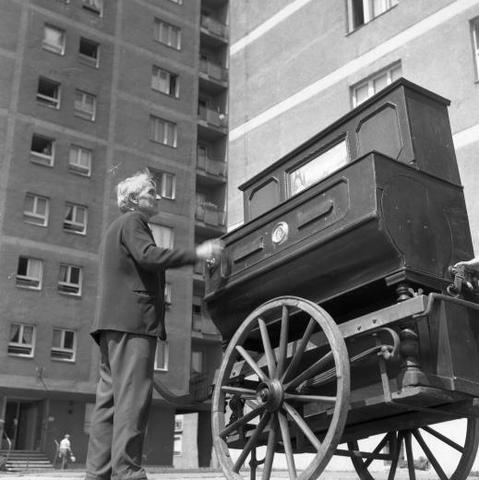 Old man (perhaps Uncle Soma) playing a barrel piano, Tahi Street, Angyalföld district, Budapest, ca. 1963
Old man (perhaps Uncle Soma) playing a barrel piano, Tahi Street, Angyalföld district, Budapest, ca. 1963|
|
Uncle Gyula, the lame huckster…
the wax-soft childlike perception, which retains such small moments, easily ignored by the adults.
 Paths of organ-grinders in Angyalföld (the places mentioned in the post, projected onto the map of the district)
Paths of organ-grinders in Angyalföld (the places mentioned in the post, projected onto the map of the district) |
For many children in Angyalföld, the organ-grinder’s music was linked to the Sunday lunch. Others for the price of an ice cream helped to push the cart, or to pick up the fifty-filler coins wrapped in newspaper, thrown from the courtyard windows. They remember the punch cards, too, and they say that the organ-grinder did not buy, but he himself made them.
This is an interesting element of the story, because, as far as we know, this type of barrel piano does not use any punch card.
Street music machines have two major types: barrel piano, what we see in the picture, and barrel organ. The latter name is often used for both types. However, in the barrel piano the keys providing the sounds are operated by a cylinder, onto which the melody is coded by nails, similarly to the little music boxes still available in game stores. Of course, the cylinder in the barrel piano can be up to forty times greater, since the length of the piece of music which can be played depends on the diameter. In the case of the barrel piano, the cylinder operates a piano structure.
This plebeian music machine also has an aristocratic brother, the player piano or pianola. At first glance it is a traditional instrument, with keyboard and foot pedals. In this they really use codes set on punch cards, which gives way to a much more finely differentiated playback. The player piano was also one of the first techniques of music recording, which could record the actual performance of a pianist, thus the result was not the machine-replay of a sterile melody line, but of a true artistic interpretation. Such recordings were made, among others, by Scott Joplin, Béla Bartók, or the young Artur Rubinstein.
It is therefore a mystery how the punch card rolls got into the above childhood memories. Perhaps there was another instrument in the neighborhood which worked on that principle, but it is also possible that the old man simply tricked the young girls. I don’t know.
This photo might show Uncle Soma from the northern Újpest district, who usually played in front of the Polgár Pub in Elizabet street, says one of the informants. Others add that an organ-grinder also lived in Petneházy street, who often played in Gyöngyösi street and the poor Tripolisz neighborhood.
Checking thoroughly the following photo from the 1930s, one thinks that perhaps the same music-machine – just some decades younger – features here in the background. Perhaps the man is also the same in the two pictures?
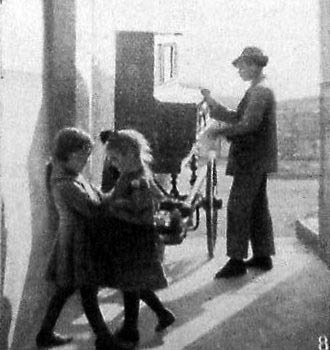
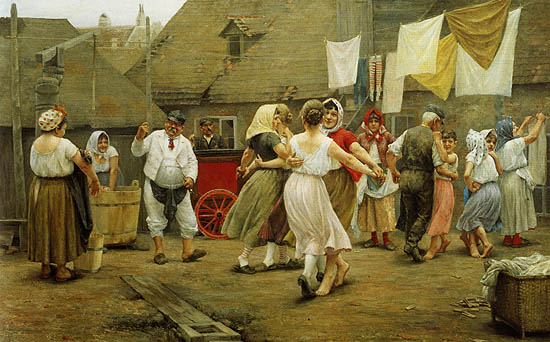
The best use of the opportunities offered by the Werkelmann (as he was called in Viennese German) is shown in Josef Engelhart’s cheerful picture of 1890
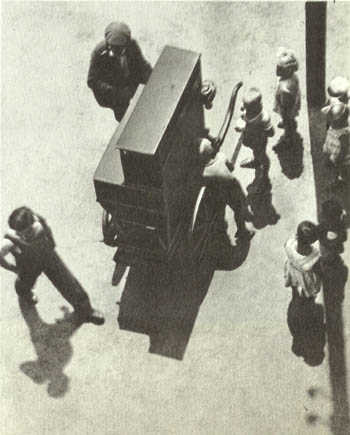 Organ-grinder in the thirties. Photo by Lajos Szabó, in: Fortélyos félelem igazgat, Móra, 1974
Organ-grinder in the thirties. Photo by Lajos Szabó, in: Fortélyos félelem igazgat, Móra, 1974According to our informants, taken from the the neighboring flat, at Attila street 150.
But there were also other ambulant performers in the district along the axis of the Váci Street. In the Tripolisz they even remember a singing beggar, such an old man that his voice did not reach the windows. Nevertheless, he also received his emoluments. In addition to the barrel organ peddlers – who often were disabled soldiers or people in need of an easy physical work for other reasons – there was also an important rival group of backyard music service: the Gypsies. They were mainly young people, who linked up the daily practicing with earning bread, going about with their violins, and playing popular hits or Hungarian songs. Angyalföld was the cradle of a good many famous Gypsy musicians, as we will tell about them in a later post.
There were also two other old men, Uncle Pista and his brother-in-law or brother… maybe they are in Iván Vydareny’s photos taken in 1960 in Angyalföld, pushing their music-machine in the Visegrádi and Gogol Streets.

And the player piano which accompanied our tour in Angyalföld, unexpectedly shows up again for a last time to tell goodbye, purchased for the scenery of the 1969 film version of Ferenc Molnár’s famous The Boys of Paul Street.
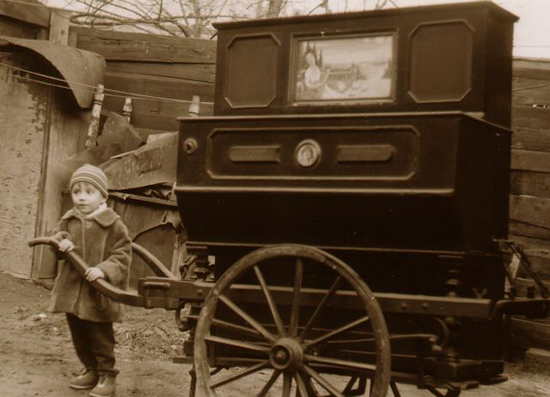
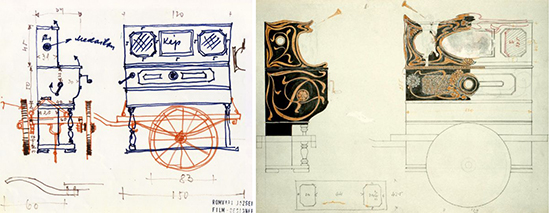
“Exactly at quarter of one, after repeated futile experiments, the tense anticipation was rewarded. Into the colorless flame of a Bunsen burner upon the classroom desk there suddenly burst a flash of bright emerald; the professor’s efforts to demonstrate the fact that the compound, whereof the professor wanted to show that paints the flame green, indeed paints the flame green; say, at quarter of one, in that triumphant minute, a barrel piano resounded in a neighboring courtyard. Whereupon all earnestness and attention instantly fled. The windows were wide open, welcoming the warmth of a March day, while the wings of fresh Spring breezes wafted music into the room. It was a rollicking Magyar melody which issued in march tempo from the barrel piano. It was so utterly hilarious an air, so Viennese in spirit, that the entire class felt tempted to smile; indeed, many among those present did not restrain this urge.”
Ferenc Molnár: The Paul Street Boys, 1.
I only knew such street musicians from a radio tale, but we loved them very much also there. (From the almost fifty-minute long tale, the organ-grinder Zakariás plays only some minutes at the beginning and in the end.)
Every mouse loves cheese. Radio game, 1980.
Zakariás: Károly Kovács – Parrot: Ferenc Háray – Aunt Lidi: Józsa Hacser – Uncle Márton: László Csákányi – Soma: Endre Harkányi – Mummy Szeréna: Éva Schubert – Daddy Albin: Samu Balázs – Fruzsina: Hédi Váradi – Big Cat Magus: Gyula Bodrogi – Chequered mice: Ildikó Meixner, Péter Csepeli – With the collaboration of the ensemble formed from the Symphonic Orchestra of the Hungarian Radio – Music and direction: Lászó Gulyás – Written and arranged: Gyula Urbán
Fogd meg a vízben a csillagot!
Hasztalan, úgysem tudod!
Idelent hiába vallatod,
fönt van a fényes titok.
Csillagba zárták a sorsodat,
csillag a vízben ragyog
Tükrödből nem tudhatsz meg sokat,
fönt van a fényes titok.Catch the star on the water!
Useless, you cannot do
In vain you interrogate it here:
the bright secret is up there.
Your fate has been closed in the
stars which shine on the water:
but your mirror won’t tell you much:
the bright secret is up there.
Update: Thanks to the appeal of the district library in the spring of 2013, two new photos have popped up from 1965. For completeness I include them here.
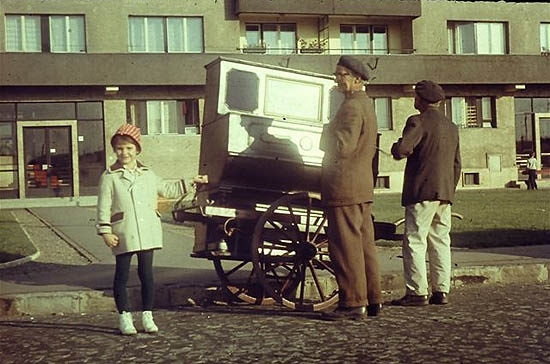
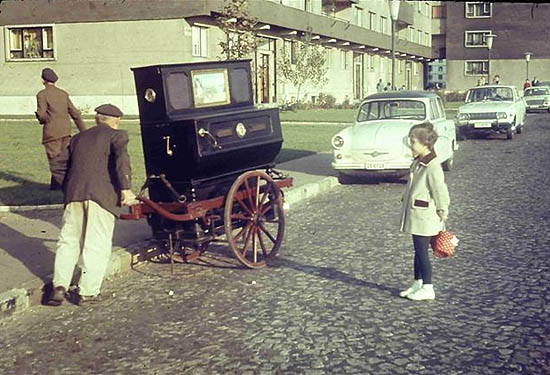

























































No hay comentarios:
Publicar un comentario